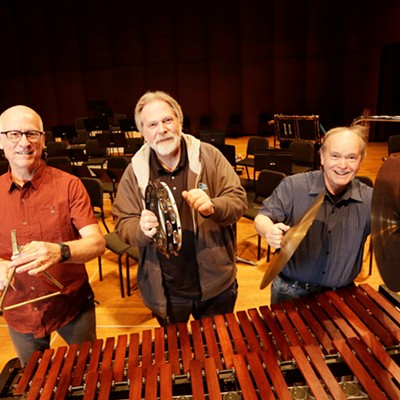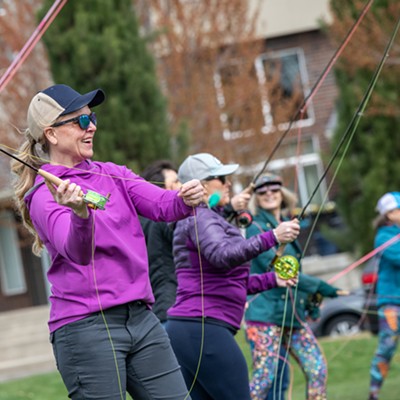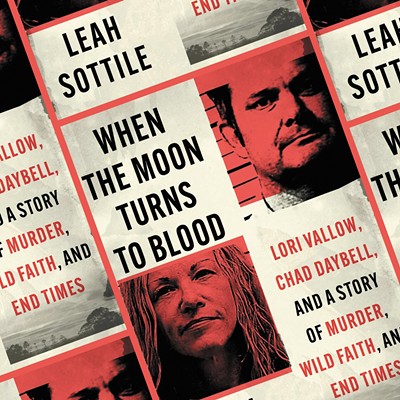If there is one thing in Janet’s life that she’s certain about, it’s that she loves her husband. She loves James so much that they are hardly ever apart: They work in the same room; they text when they’re not. They read books together in bed at night, taking turns to read aloud to each other.
But about five years ago, Janet found out that James — the couple spoke on the condition their real names be withheld — had an affair with another woman. “That just about killed me,” she says. Even James was confused by his own actions. It wasn’t that he didn’t love her — in fact, he loved her deeply. But inside a feeling nagged at him that he had more love to give.
That’s when “polyamory” entered Janet’s vocabulary. She had been married once before and wasn’t going to walk away from James, even if it meant sharing him.
“We threw out the ‘I’m leaving card’ a long time ago and just said whatever it is, we have to figure out how we go forward together,” she says.
On a freezing early January evening, Janet — a 58-year-old dirty blonde in a Harley Davidson shirt — sits next to James at a Spokane Valley Shari’s Restaurant, poking at a dinner salad. James is 55, with a handlebar mustache, glasses and a black Harley T-shirt, and he now organizes the Inland Northwest Polyamory group, which is meeting at the restaurant tonight.
Janet attends these meetings, but it’s not easy for her to be here. Sometimes called “ethical non-monogamy,” polyamory describes relationships that aren’t bound by traditional marital constrictions. Where a ring and a vow bind most of American society in heterosexual pairs for life, polyamorists — like believers in the 1960s “free love” movement — believe deep relationships and marriages shouldn’t be restrictive.
In practice, polyamory sometimes unfolds simply: Couples have open marriages where one or both parties engage in deep emotional bonds and sexual relations with others freely. Sometimes several married couples engage in “group marriages,” in which a couple may share a home with another couple, called a “pod” or “intentional community.” Some pods have children with each other, too, creating poly families with several Mommys and Daddys. In other cases, one couple might take on a third partner to create a “triad.” And, still, under the polyamory umbrella, a single person may engage in several deep relationships.
At first, Janet agreed to try swinging. The pair tried sex with another couple.
“Finally I go, ‘This is not working for me. Sorry. Tried it. Don’t like it. All I want is you,’” Janet says. Swinging wasn’t really for James either, though — too hollow and carnal, not enough emotion or love.
“I always knew that I was a peg trying to fit in a hole that didn’t match the size and shape of my peg,” he says. “What I thought I was looking for and what I was looking for were not the same thing.”
He started reading self-help books, combing volume after volume, desperately searching for a name or label or an affliction for a person like him. One day, in a book called One: Love, Sex and Life in an Open Marriage, he found what he was looking for. Polyamorous.
“I’m sitting here reading this book and I’m just in tears. It’s like, ‘There’s somebody like me out there.’”
Polyamory often receives criticism for its shirking of the traditional marital views, but also for its “have your cake and eat it too” mentality. But many polyamorists dismiss such attacks, claiming poly relationships are grounded in honesty and a freedom from deception.
Despite more mention of the lifestyle in mainstream media — from Tilda Swinton’s admission of an open marriage to the Showtime reality show Polyamory: Married and Dating — polyamory remains a fringe lifestyle. For this story, most subjects asked The Inlander to omit their real names for fear that their jobs, friendships and family relationships could be jeopardized. But many crave to be out of the closet about their lifestyles — seeing the recent statewide passage of same-sex marriage rights as a step toward mainstream acceptance for polyamory.
But for someone like Janet, she’s still trying to figure out what this all means for her. For the past two years, she’s seen James jump into the poly lifestyle head first: posting ads online to meet new women, going on dates with others. He took the reins of this group — formerly the Spokane Polygamy Group — after attending a few meetings. He found the group on Meetup.com, which was tagged as “poly-friendly” and found that many members leaned toward polyamory instead of polygamy.
And, for the past two years, Janet has watched James leave their house to go on dates with another woman: a 43-year-old thin blonde photographer named Marie.
“I am totally committed to being my wife’s husband. I don’t want to be married to anyone else. She is a wonderful human being,” James says. “The young lady that I happen to date is significantly different in personality than my wife is. My wife is very focused, very business-oriented. She doesn’t necessarily like this when I say this, but she’s the alpha female. If there was a pack, she would be the leader. And the other girl I see is not that way at all. She’s very submissive, very artistic.
“[Janet] does have ultimate veto power. If she said, ‘You know that this is just not going to work,’ that’s the position that she’s in,” he says.
After years of grappling with polyamory, Janet has come to believe that James is not choosing to be polyamorous. He’s intrinsically wired this way. “I’ve never experienced jealousy. I don’t understand how that concept works. I see it in people. But I don’t know how it would feel,” James says.
Loving More, a polyamory nonprofit and website, argues that can be true for some people. For others, poly life is a philosophical choice.
Janet remains monogamous despite her husband’s poly lifestyle. “I am totally monogamous, and as much as in the last couple years I’ve struggled and tried to adapt, conform — whatever you want to call it — if anything, it’s reaffirmed in me, I am just monogamous. I am totally committed. I can’t visualize being with someone else or having another relationship outside my husband.”
When he goes on dates with Marie, Janet tries to occupy herself at home.
“My goal is to get to where I can enjoy the evenings. And I have had some where I’ve done sewing, done some other things, so that the time when he’s gone, I can look forward to it.”
In mid-January, at another group meet-up, a long table at downtown Spokane’s Post Street Ale House is filled with beers as people talk loudly in ones and twos. When servers approach the table, they pause their chatter about poly life.
At the far end sits Lee and Samson, both 32 and also using fake names. She has brown and blonde curls. He has a dark mustache and a camo-print AC/DC hat on. The two moved here a year ago with their four children from southern Idaho and are now co-organizers of the poly group.
In their nine years of marriage, they’ve been “open” for eight. For six years, they had an ongoing poly “pod” relationship with another married couple. In this group, they think of themselves of veterans of the lifestyle.
They talk of how lucky they feel to have found each other.
“We had no idea coming into this relationship that we’d ever end up where we’re at. As far as we were concerned, we were mono, vanilla, part of the average American Dream,” Samson says.
When Lee came out as bisexual, confessing that she wanted a girlfriend, she was shocked that Samson thought it was a good idea. “I was on board the whole time. I’m a really easy-going guy and I believe in equality and freedom with my partner,” Samson says.
Samson says they’ve made mistakes along the way — and they’re here to share those mistakes with others as a way of mentoring them into the poly life.
They say their relationship is solid because they set ground rules: Whatever Lee does, Samson can do, too; they have veto power over the other persons’ relationships; they always use protection; family — above everything — always comes first.
“Once we [set rules] we were really able to get things put into a good perspective and move forward safely, honestly,” he says.
Today, they have found a perfect girl for them both to share.
“Right now we’re really focusing on the one-hard-to-find relationship — which is a single lady that’s interested in both of us. Which is super rare. They call it a ‘unicorn’ for a very good reason. It’s a mystical creature that’s hard to find,” Samson says, laughing. “We found ours at this point. And we haven’t gone the full mile with it, but we’re working on it.
“This morning I texted her and asked her if she wanted to come over for quiche and hashbrowns and coffee,” he says. “And so she came over and we did that. Hung out for a while. Been on a couple dates. So we’re really cultivating a relationship with this person.”
Where James and Janet don’t have to worry about explaining their lives to children, Samson and Lee do. The couple has four children — ranging from ages 8 to 13. Recently Lee explained polyamory to her youngest daughter.
“[I said], ‘It’s possible that someday Mommy and Daddy are going to have somebody else live with us. … You know we love each other, but we know we can love somebody else too and they could be a part of our life,’” Lee recounts. “And she said, ‘Oh, like a stepmom?’ And I said ‘Kind of, but I would still be a part of the relationship. And she’s all, ‘It might be cool to have another mom.’”
Lee laughs when she says how surprised she was when that same daughter showed her understanding of polyamory when she met the couple’s new girlfriend.
“She met my potential girlfriend, and after she left she goes ‘Mom! She might be your special lady! … But I know that Daddy is going to want to take her out sometimes.’”
“And I said, ‘That’s OK with me. I am perfectly OK with that.’”
At the opposite end of the long table, James sits with his arm around Marie’s back — both engaged in separate conversations. Marie stands up at one point and lifts her shirt high to show another member the flower tattoo spiraling down the side of her body.
James says that his wife, Janet, might be slightly bitter toward Marie and his polyamorous lifestyle. “It wasn’t what she signed up for,” he says, matter of factly.
But as the years have passed, he’s seen his wife become friendlier toward Marie. They’re not friends — and Janet hates when he comes home smelling like Marie’s cigarettes — but they’re civil to each other.
“She understands me and tolerates it,” James says.
Last year he was shocked when Janet and Marie pooled their money at Christmas to buy a hotel room for he and Marie to enjoy.
“I knew nothing about it at all,” he says. “When [Janet] is like that, I tell her, ‘It’s like you’ve got your mojo on when you’re like that.’ And that’s very attractive to me when she’s supportive of the relationship we have. It brings me closer to her, too.”
With Marie, he goes to bars and clubs. They ride motorcycles when the weather is nice. “She’s a great little rider.” He likes to watch her shoot photos.
“I have never been happier in the relationships as I am right now. I’m more at peace with who I am. And [Marie] and [Janet] are both different personalities, but I feel like each of them adds to me,” he says.
Marie nods. She wonders aloud why more people aren’t willing to open their relationships to other people. “If more people were open about it, it would be similar to, like, an explosion.”
The table nods in agreement.


















